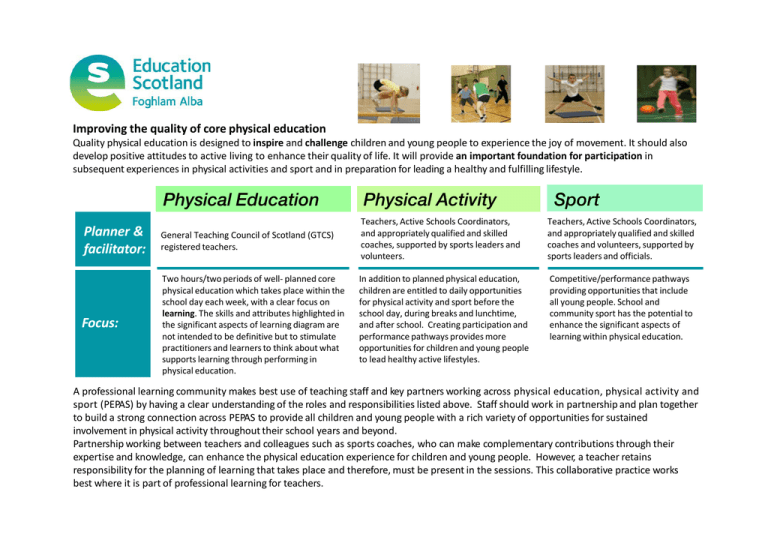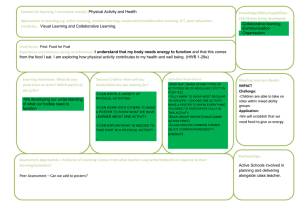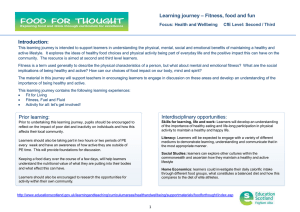Improving the quality of core physical education
advertisement

Improving the quality of core physical education Quality physical education is designed to inspire and challenge children and young people to experience the joy of movement. It should also develop positive attitudes to active living to enhance their quality of life. It will provide an important foundation for participation in subsequent experiences in physical activities and sport and in preparation for leading a healthy and fulfilling lifestyle. Physical Education Physical Activity Sport Planner & facilitator: General Teaching Council of Scotland (GTCS) registered teachers. Teachers, Active Schools Coordinators, and appropriately qualified and skilled coaches, supported by sports leaders and volunteers. Teachers, Active Schools Coordinators, and appropriately qualified and skilled coaches and volunteers, supported by sports leaders and officials. Focus: Two hours/two periods of well- planned core physical education which takes place within the school day each week, with a clear focus on learning. The skills and attributes highlighted in the significant aspects of learning diagram are not intended to be definitive but to stimulate practitioners and learners to think about what supports learning through performing in physical education. In addition to planned physical education, children are entitled to daily opportunities for physical activity and sport before the school day, during breaks and lunchtime, and after school. Creating participation and performance pathways provides more opportunities for children and young people to lead healthy active lifestyles. Competitive/performance pathways providing opportunities that include all young people. School and community sport has the potential to enhance the significant aspects of learning within physical education. A professional learning community makes best use of teaching staff and key partners working across physical education, physical activity and sport (PEPAS) by having a clear understanding of the roles and responsibilities listed above. Staff should work in partnership and plan together to build a strong connection across PEPAS to provide all children and young people with a rich variety of opportunities for sustained involvement in physical activity throughout their school years and beyond. Partnership working between teachers and colleagues such as sports coaches, who can make complementary contributions through their expertise and knowledge, can enhance the physical education experience for children and young people. However, a teacher retains responsibility for the planning of learning that takes place and therefore, must be present in the sessions. This collaborative practice works best where it is part of professional learning for teachers. A quality physical education programme will be planned, facilitated and evaluated by GTCS registered teachers and take place during timetabled school day with all learners participating. Partners can make complementary contributions to learning through their specialist expertise and knowledge but it is the teacher who will be responsible for learners and learning and who will ensure that the following components are evident: • Planned – Within physical education, planning for the application of skills and the development of transferable skills for learning, life and work. Learners should be supported to understand how much and how well they have learned and should be involved in planning their next steps. • Focus on learning – teachers facilitate and make use of a variety of approaches including active, collaborative and independent learning together with effective use of technology to provide experiences for learners with opportunities to evaluate, analyse, create and solve problems. They take responsibility for their own learning by applying knowledge and transferable skills in a range of contexts. • Enjoyable – learners should find physical education challenging, engaging and motivating. They actively engage in their learning in physical education because the enjoyment they derive from the experience gives them a sense of purpose and is intrinsically rewarding. • Diverse – learners should experience a wide range of purposeful and challenging physical activities which encompass: competitive, collaborative and cooperative, group and individual, indoor, outdoor, aquatic, creative, adaptable and technical, high energy and relaxing activities • Progressive – regular professional dialogue and collaborative planning, including the moderation of assessment evidence at key transitional stages, will ensure learners progress seamlessly and continue to be challenged from 3 -18. This will support the development of the significant aspects of learning from simple and predictable contexts to a range of more complex and unpredictable contexts. Significant aspects of learning in physical education Movement skills, competencies and concepts Cooperation and competition Evaluating and appreciating simple HWB 21-22a HWB 23a HWB 24a progressive learning contexts as the learner develops capacity and competence predictable self paced limited repertoire of skills complex unpredictable The significant aspects of learning in physical education should be regularly revisited through a broad range of relevant and realistic learning experiences across all levels externally paced wide repertoire of skills problem solving limited pressure kinaesthetic awareness focus & concentration balance & control decision making creativity motivation confidence & self esteem determination & resilience responsibility & leadership pressure of increased variables with less time to respond coordination & fluency Cognitive Skills Physical Competencies skills and attributes that support learning through performing in physical education Personal Qualities Physical Fitness rhythm & timing gross & fine motor skills stamina speed core stability & strength flexibility respect & tolerance communication Transforming lives through learning www.educationscotland.gov.uk






